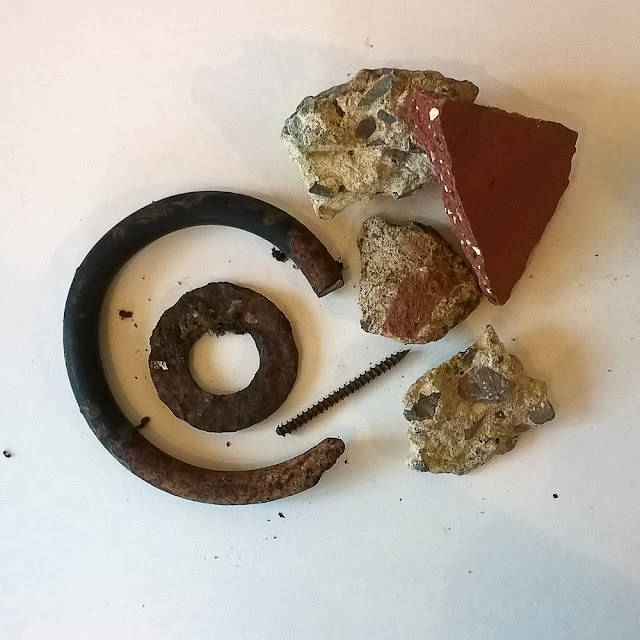A Natural Dye Project Using Materials From Derelict Land
The online Environmental Humanities MOOC I have been doing has sadly finished. I still can't define exactly what Environmental Humanities is. It might have something to do with thinking about what could be done to improve the environment. It definitely didn't tackle the practical side to the problem. Maybe the one thing I did gain was an appreciation of how entangled Nature and Humanity are. There is no longer any 'out there', and probably never was.
Part of the course was to do an art project about an environmental concern we have. Actually we were supposed to make a Creative Intervention. That sounded too assertively ambitious for me, so I decided to stick to what I know: some natural dyeing.
There was also the problem of which concern to pick. I'm concerned about all of it. In the end I stayed loyal to the theme of this blog and did something arty about nature in the city.
Ever since I found Weld and Bee Orchids growing in a local disused petrol station I've become obsessed with the square patch of concrete and weeds, and regularly make a spectacle of myself by stomping through it taking photos and pulling up plants to take back home to identify. Manchester readers will know this plot. It's on the corner of Fog Lane and Kingsway.
On one level it's horrible. Cars zoom past on the A road, there is broken glass, and suspicious looking people loitering. Travellers once set up camp there. On another, it is an island of wild unchecked growth. It is fascinating to see what grows there. None of which has been deliberately planted or managed.
I have done some dyeing with plants from there before. The Weld was particularly spectacular. This time I wanted to use not only the plants, but also the manmade materials that make the site what it is. In this way, whatever colour was produced would be the result of the organic and inorganic chemistry which is unique to that place. Since dye is really a transfer of molecules from plant to cloth the final colour would be the literal representation of the plot.
Of course winter is not the time to go plant hunting. Most of the plants were waving about as old sticks, or lying low in sullen clumps. I randomly grabbed as much as I could without worrying about what species they were, stuffed them into a plastic bag, and hoped no one would ask what I was doing. I deserve a medal for getting any colour at all to be honest.
And what of the manmade dyestuff? This was broken bits of concrete, iron and roof tiles. I knew iron is a potent colour maker. It reliably produces black and grey, as well as rust orange. The concrete and roof tile were not used for their dyeing properties, but the effect their chemistry would have on the uptake of colour.
Concrete is made from Portland cement which is an amalgam of limestone, clay and gypsum, a calcium compound. Natural dyeing is a tricky business. It is not as a reliable process as dyeing with industrially made dyes. There is a lot of coaxing and witchcraft. One of the things you can do is change the pH of the dyebath to a more alkaline environment. This assists the chemical process that attaches colour particles to the cloth. I normally throw in some washing soda, but it occurred to me that the limestone and calcium in concrete would do the same job. To test the idea I crushed some up, put it in hot water and dipped in a strip of litmus paper.
 |
| Dark green shows crushed concrete is alkaline. Tap water is less so. |
Surprisingly I was right. The chalk, and the clay from the roof tiles would also add to the whole cauldron of chemistry.
So I shoved everything I found into some jars with squares of cotton cloth, then heated up the strange soup.
Then it was a matter of doing some stitching and a small wall hanging was made that hopefully demonstrates in a convoluted arty way that it is not easy to define unnatural and natural. It relates to ideas mentioned in the post Nature-Culture Binary.
If I had to write a serious report on the project for the online course I would add a section on taking the idea further. If this was done professionally you could run workshops where urban nature was discussed while people foraged for materials. The very best expression would be to make cloth, yarn or cordage from the plants actually growing on the site. In 2011 in Manchester flax was grown on a brownfield site. I've got some of the yarn that was spun from the harvest. Wouldn't it be great to weave it into cloth then dye that? Perhaps cord could be made from nettles.
There is a lot of scope to develop this idea. Even political issues around common land and public space could be worked into it. However, that is enough of the Humanities for now. We're back to Science next week.
This is the same corner of Fog Lane and Kingsway in the 1940s. Look how clean and calm it was.
Sorry about the dull title and sub-heading - I'm trying to improve Garden65's SEO.
Growing flax in Manchester





